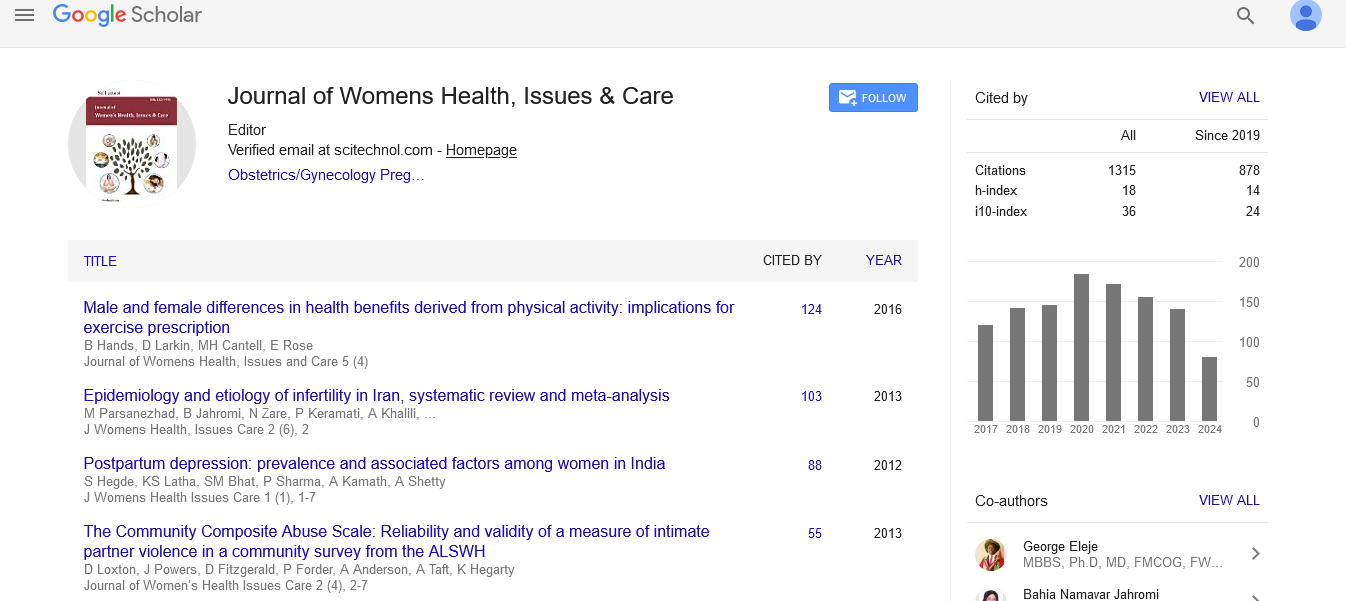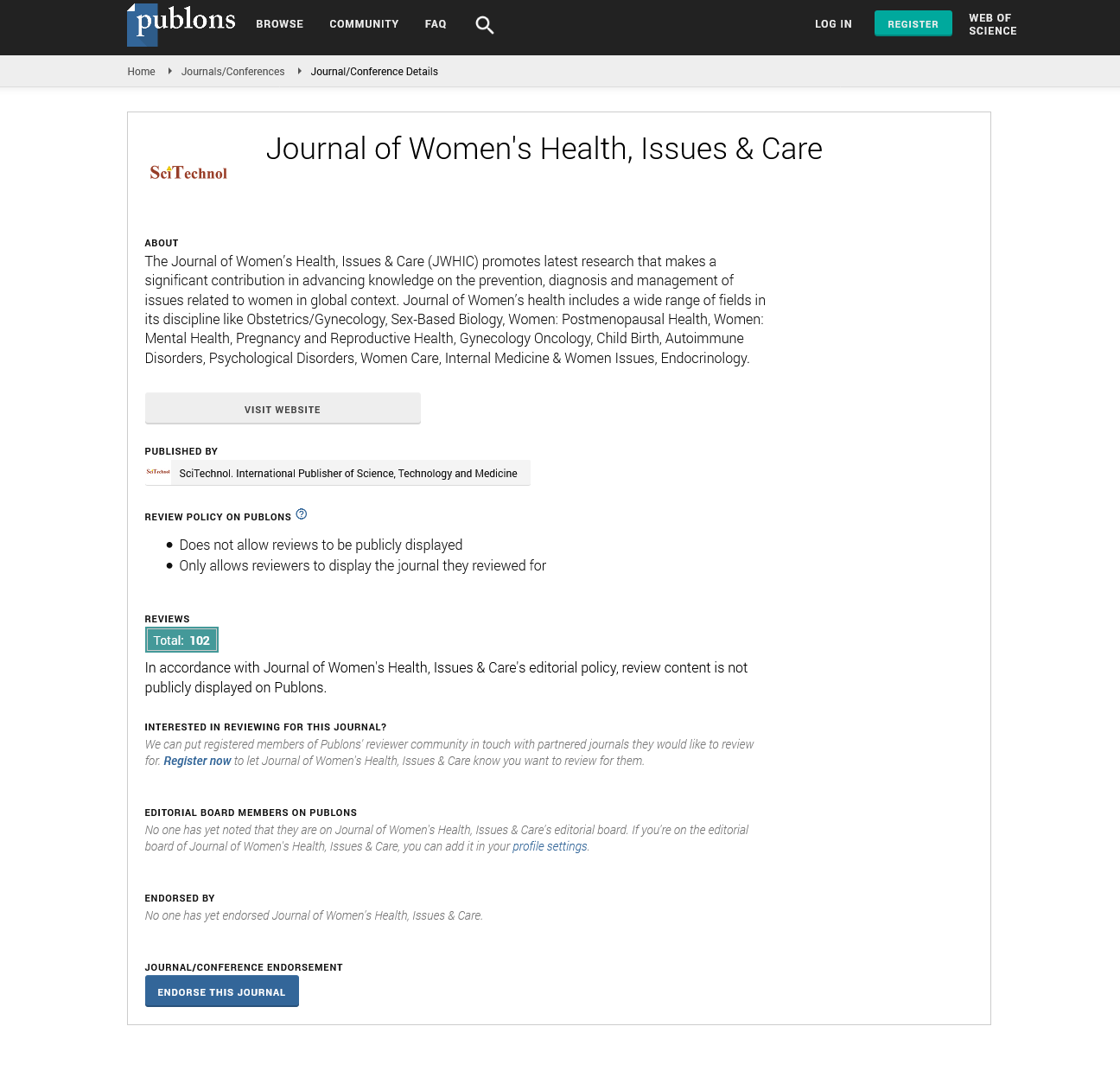Opinion Article, J Womens Health Vol: 13 Issue: 6
Osteoporosis: Prevention and Treatment for Women
Yasnin Wei*
1Department of Geriatrics and Osteoporosis, Charite University Medicine, Berlin, Germany
*Corresponding Author: Yasnin Wei,
Department of Geriatrics and Osteoporosis,
Charite University Medicine, Berlin, Germany
E-mail: yasnin_wei23z@gmail.com
Received date: 26 November, 2024, Manuscript No. JWHIC-24-156659;
Editor assigned date: 28 November, 2024, PreQC No. JWHIC-24-156659 (PQ);
Reviewed date: 12 December, 2024, QC No. JWHIC-24-156659;
Revised date: 20 December, 2024, Manuscript No. JWHIC-24-156659 (R);
Published date: 27 December, 2024, DOI: 10.4172/2325-9795.1000532.
Citation: Wei Y (2024) Osteoporosis: Prevention and Treatment for Women. J Womens Health 13:6.
Description
Osteoporosis is a silent condition that primarily affects women, characterized by weakened bones that are more susceptible to fractures. It is a significant public health concern, particularly as women age, due to their higher risk of developing the disease compared to men. While osteoporosis often progresses without symptoms, its consequences can be severe, leading to fractures, loss of mobility and a reduced quality of life. Understanding the risk factors, prevention strategies and treatment options is essential for addressing this widespread condition and improving women’s bone health. One of the primary risk factors for osteoporosis in women is the decrease in estrogen levels that occurs during menopause. Estrogen is a hormone that plays an important role in maintaining bone density by inhibiting bone resorption. As women enter menopause, the sharp decline in estrogen accelerates bone loss, increasing the risk of osteoporosis. In addition to hormonal changes, women tend to have smaller, thinner bones, which also make them more prone to osteoporosis. Other factors, such as a family history of the disease, age and low body weight, further contribute to the increased risk.
Certain lifestyle choices can also significantly influence the development of osteoporosis. A diet low in calcium and vitamin D, essential nutrients for bone health, can impair bone formation and contribute to bone loss. Physical inactivity is another risk factor, as weight-bearing exercises and activities such as walking running and strength training help maintain bone density. Smoking and excessive alcohol consumption further exacerbates bone loss by impairing bone formation and increasing bone resorption. Prevention is the most effective strategy for managing osteoporosis. Ensuring an adequate intake of calcium and vitamin D is essential for maintaining strong bones. Women should aim to consume at least 1,000 mg of calcium daily, increasing to 1,200 mg after the age of 50. Vitamin D, which aids in calcium absorption, should be taken in sufficient amounts, with recommendations typically ranging from 600 IU to 800 IU daily for most women. Dairy products, leafy green vegetables, fortified cereals and fatty fish are excellent sources of these nutrients. In addition, exposure to sunlight, which helps the body produce vitamin D, is important for bone health.
Weight-bearing exercise is one of the most effective ways to prevent osteoporosis and promote bone strength. Activities such as walking, jogging, dancing and weightlifting stimulate bone formation and slow the rate of bone loss. Regular physical activity also helps improve balance and coordination, reducing the risk of falls and fractures. Women should aim for at least 30 minutes of moderate exercise most days of the week to support bone health. In addition to lifestyle modifications, medical treatments can play an important role in preventing and managing osteoporosis. Medications such as bisphosphonates, which inhibit bone resorption, are commonly prescribed for women with osteoporosis. Other medications, such as Selective Estrogen Receptor Modulators (SERMs) and Hormone Replacement Therapy (HRT), can help reduce the effects of low estrogen levels and slow bone loss. Denosumab, a monoclonal antibody, is another treatment option that reduces bone resorption. In some cases, parathyroid hormone therapies may be used to stimulate bone formation in women with severe osteoporosis.
Regular bone density testing, such as Dual-Energy X-ray Absorptiometry (DEXA) scans, is an important tool for detecting osteoporosis early, especially in women who are at higher risk due to factors such as age, family history or menopause. Early detection allows for the initiation of preventive measures and treatment, reducing the likelihood of fractures and other complications. While osteoporosis is a chronic condition that requires lifelong management, women can take proactive steps to reduce their risk and maintain bone health. A combination of a healthy diet, regular exercise, and, when necessary, medications, can significantly improve bone density and decrease the risk of fractures. It is essential for women to engage in open discussions with healthcare providers to assess their risk for osteoporosis, adopt preventive strategies and seek appropriate treatment when needed.
Conclusion
Osteoporosis poses a significant health threat to women, particularly after menopause. However, by addressing lifestyle factors such as nutrition and physical activity and utilizing medical treatments when necessary, women can reduce their risk of developing osteoporosis and manage the condition effectively. Early prevention and intervention are key to preserving bone health and improving quality of life for women as they age.
 Spanish
Spanish  Chinese
Chinese  Russian
Russian  German
German  French
French  Japanese
Japanese  Portuguese
Portuguese  Hindi
Hindi 



